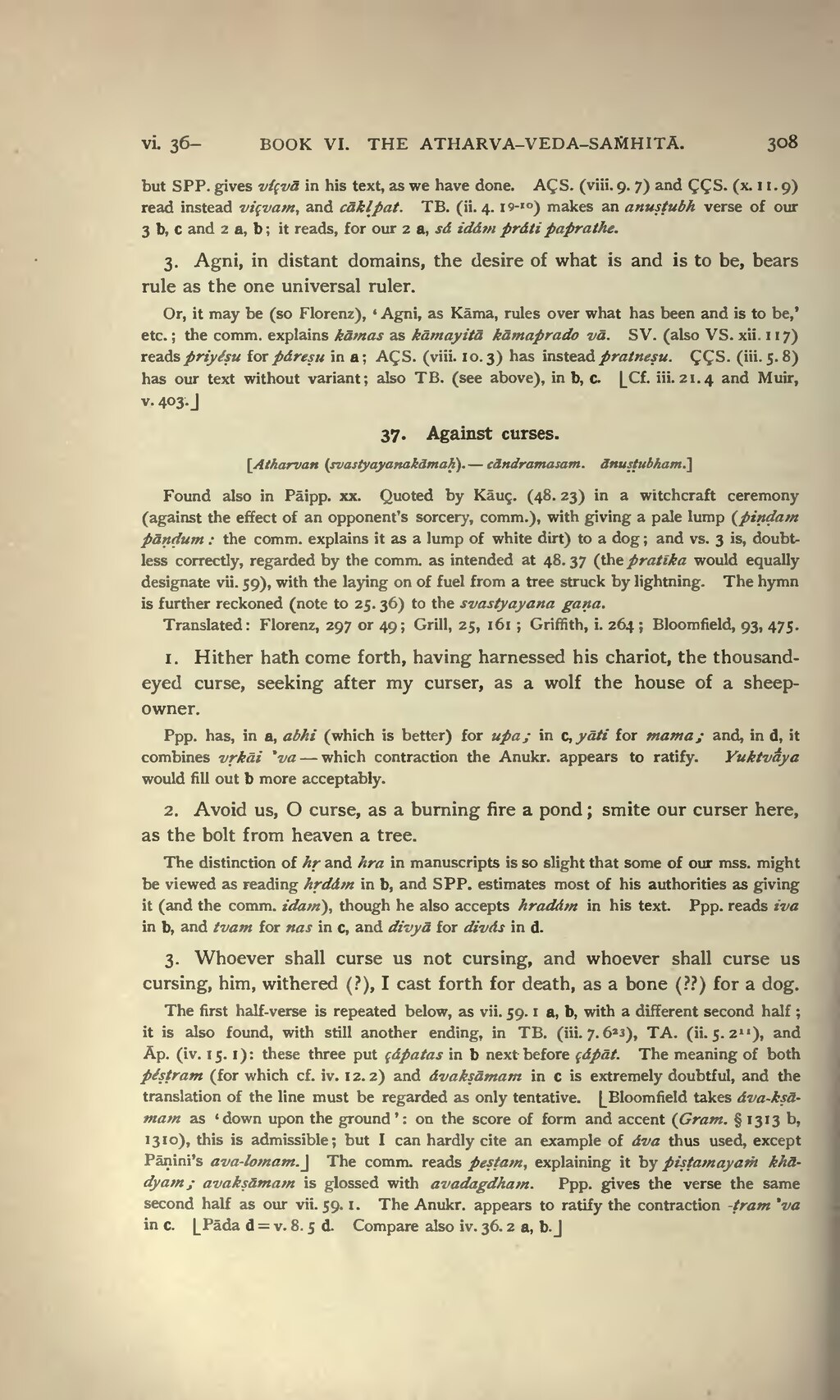3. Agni, in distant domains, the desire of what is and is to be, bears rule as the one universal ruler.
Or, it may be (so Florenz), 'Agni, as Kāma, rules over what has been and is to be,' etc.; the comm. explains kāmas as kāmayitā kāmaprado vā. SV. (also VS. xii. 117) reads priyéṣu for páreṣu in a; AÇS. (viii. 10.3) has instead pratneṣu. ÇÇS. (iii. 5. 8) has our text without variant; also TB. (see above), in b, c. ⌊Cf. iii. 21. 4 and Muir, v. 403.⌋
37. Against curses.
[Atharvan (svastyayanakāmaḥ).—cāndramasam. ānuṣṭubham.]
Found also in Pāipp. xx. Quoted by Kāuç. (48. 23) in a witchcraft ceremony (against the effect of an opponent's sorcery, comm.), with giving a pale lump (piṇḍam pāṇḍum: the comm. explains it as a lump of white dirt) to a dog; and vs. 3 is, doubtless correctly, regarded by the comm. as intended at 48. 37 (the pratīka would equally designate vii. 59), with the laying on of fuel from a tree struck by lightning. The hymn is further reckoned (note to 25. 36) to the svastyayana gaṇa.
Translated: Florenz, 297 or 49; Grill, 25, 161; Griffith, i. 264; Bloomfield, 93, 475.
1. Hither hath come forth, having harnessed his chariot, the thousand-eyed curse, seeking after my curser, as a wolf the house of a sheepowner.
Ppp. has, in a, abhi (which is better) for upa; in c, yāti for mama; and, in d, it combines vṛkāi ’va—which contraction the Anukr. appears to ratify. Yuktvā́ya would fill out b more acceptably.
2. Avoid us, O curse, as a burning fire a pond; smite our curser here, as the bolt from heaven a tree.
The distinction of hṛ and hra in manuscripts is so slight that some of our mss. might be viewed as reading hṛdám in b, and SPP. estimates most of his authorities as giving it (and the comm. idam), though he also accepts hradám in his text. Ppp. reads iva in b, and tvam for nas in c, and divyā for divás in d.
3. Whoever shall curse us not cursing, and whoever shall curse us cursing, him, withered (?), I cast forth for death, as a bone (?) for a dog.
The first half-verse is repeated below, as vii. 59. 1 a, b, with a different second half; it is also found, with still another ending, in TB. (iii. 7. 623), TA. (ii. 5. 211), and Āp. (iv. 15. 1): these three put çápatas in b next before çápāt. The meaning of both péṣṭram (for which cf. iv. 12. 2) and ávakṣāmam in c is extremely doubtful, and the translation of the line must be regarded as only tentative. ⌊Bloomfield takes áva-kṣāmam as 'down upon the ground': on the score of form and accent (Gram. §1313 b, 1310), this is admissible; but I can hardly cite an example of áva thus used, except Pāṇini's ava-lomam.⌋ The comm. reads peṣṭam, explaining it by piṣṭamayaṁ khādyam; avakṣāmam is glossed with avadagdham. Ppp. gives the verse the same second half as our vii. 59. 1. The Anukr. appears to ratify the contraction -ṭram ’va in c. ⌊Pada d = v. 8. 5 d. Compare also iv. 36. 2 a, b.⌋
